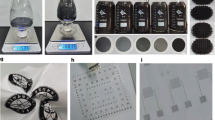Abstract
There is keen interest in the use of amorphous WO3 thin films as cathodic electrodes in transmittance-modulating electrochromic devices1,2,3,4. However, these films suffer from ion-trapping-induced degradation of optical modulation and reversibility on extended Li+-ion exchange. Here, we demonstrate that ion-trapping-induced degradation, which is commonly believed to be irreversible, can be successfully eliminated by constant-current-driven de-trapping; that is, WO3 films can be rejuvenated and regain their initial highly reversible electrochromic performance. Pronounced ion trapping occurs when x exceeds ∼0.65 in LixWO3 during ion insertion. We find two main kinds of Li+-ion-trapping site (intermediate and deep) in WO3, where the intermediate ones are most prevalent. Li+ ions can be completely removed from intermediate traps but are irreversibly bound in deep traps. Our results provide a general framework for developing and designing superior electrochromic materials and devices.
This is a preview of subscription content, access via your institution
Access options
Subscribe to this journal
Receive 12 print issues and online access
$259.00 per year
only $21.58 per issue
Buy this article
- Purchase on Springer Link
- Instant access to full article PDF
Prices may be subject to local taxes which are calculated during checkout




Similar content being viewed by others
References
Llordes, A., Garcia, G., Gazquez, J. & Milliron, D. J. Tunable near-infrared and visible light transmittance in nanocrystal-in-glass composites. Nature 500, 323–332 (2013).
Granqvist, C. G. Electrochromics for smart windows: Oxide-based thin films and devices. Thin Solid Films 564, 1–38 (2014).
Niklasson, G. A. & Granqvist, C. G. Electrochromics for smart windows: Thin films of tungsten oxide and nickel oxide, and devices based on these. J. Mater. Chem. 17, 127–156 (2007).
Granqvist, C. G. Electrochromic materials: Out of a niche. Nature Mater. 5, 89–90 (2006).
Granqvist, C. G. Handbook of Inorganic Electrochromic Materials (Elsevier, 1995).
Faughnan, B. W., Crandall, R. S. & Heyman, P. M. Electrochromism in WO3 amorphous films. RCA Rev. 36, 177–197 (1975).
Hashimoto, S. & Matsuoka, H. Prolonged lifetime of electrochromism of amorphous WO3–TiO2 thin films. Surf. Interface Anal. 19, 464–468 (1992).
Arvizu, M. A., Triana, C. A., Stefanov, B. I., Granqvist, C. G. & Niklasson, G. A. Electrochromism in sputter-deposited W–Ti oxide films: Durability enhancement due to Ti. Sol. Energy Mater. Sol. Cells 125, 184–189 (2014).
Hashimoto, S. & Matsuoka, H. Lifetime and electrochromism of amorphous WO3–TiO2 thin films. J. Electrochem. Soc. 138, 2403–2408 (1991).
Niklasson, G. A., Malmgren, S., Green, S. & Backholm, J. Determination of electronic structure by impedance spectroscopy. J. Non-Cryst. Solids 356, 705–709 (2010).
Bressers, P. M. M. C. & Meulenkamp, E. A. The electrochromic behavior of indium tin oxide in propylene carbonate solutions. J. Electrochem. Soc. 145, 2225–2230 (1998).
Li, W.-J. & Fu, Z.-W. Nanostructured WO3 thin film as a new anode material for lithium-ion batteries. Appl. Surf. Sci. 256, 2447–2452 (2010).
Hashimoto, S., Matsuoka, H., Kagechika, H., Susa, M. & Goto, K. S. Degradation of electrochromic amorphous WO3 film in lithium-salt electrolyte. J. Electrochem. Soc. 137, 1300–1304 (1990).
Bisquert, J. Analysis of the kinetics of ion intercalation: Ion trapping approach to solid-state relaxation processes. Electrochim. Acta 47, 2435–2449 (2002).
Garcia-Belmonte, G., Bueno, P. R., Fabregat-Santiago, F. & Bisquert, J. Relaxation processes in the coloration of amorphous WO3 thin films studied by combined impedance and electro-optical measurements. J. Appl. Phys. 96, 853–859 (2004).
Fabregat-Santiago, F. et al. Dynamic processes in the coloration of WO3 by lithium insertion. J. Electrochem. Soc. 148, E302–E309 (2001).
Bisquert, J. & Vikhrenko, V. S. Analysis of the kinetics of ion intercalation. Two state model describing the coupling of solid state ion diffusion and ion binding processes. Electrochim. Acta 47, 3977–3988 (2002).
Bisquert, J. Fractional diffusion in the multiple-trapping regime and revision of the equivalence with the continuous-time random walk. Phys. Rev. Lett. 91, 010602 (2003).
Bisquert, J. Beyond the quasistatic approximation: Impedance and capacitance of an exponential distribution of traps. Phys. Rev. B 77, 235203 (2008).
Berggren, L., Jonsson, J. C. & Niklasson, G. A. Optical absorption in lithiated tungsten oxide thin films: Experiment and theory. J. Appl. Phys. 102, 083538 (2007).
Hjelm, A., Granqvist, C. G. & Wills, J. M. Electronic structure and optical properties of WO3, LiWO3, NaWO3, and HWO3 . Phys. Rev. B 54, 2436–2445 (1996).
Yoon, S., Woo, S-G., Jung, K.-N. & Song, H. Conductive surface modification of cauliflower-like WO3 and its electrochemical properties for lithium-ion batteries. J. Alloys Compd. 613, 187–192 (2014).
Knowles, T. J. Optical regeneration of aged WO3 electrochromic cells. Appl. Phys. Lett. 31, 817–818 (1977).
Mayer, M. SIMNRA, a simulation program for the analysis of NRA, RBS and ERDA. Am. Inst. Phys. Conf. Proc. 475, 541–544 (1999).
Ulfheil, J., Würsig, A., Schneider, O. D. & Novák, P. Acetone as oxidative decomposition product in propylene carbonate containing battery electrolyte. Electrochem. Commun. 7, 1380–1384 (2005).
Georén, P. & Lindbergh, G. On the use of voltammetric methods to determine electrochemical stability limits for lithium battery electrolytes. J. Power Sources 124, 213–220 (2003).
Acknowledgements
We acknowledge support with RBS measurements from D. Primetzhofer and the staff of the Tandem accelerator laboratory at Uppsala University. Assistance was received from M. Arvizu and C. Triana for sample preparation. Financial support was received from the European Research Council under the European Community’s Seventh Framework Program (FP7/2007–2013)/ERC Grant Agreement No. 267234 (‘GRINDOOR’).
Author information
Authors and Affiliations
Contributions
R.-T.W conceived the idea, designed and performed the experiments. R.-T.W. carried out the data analysis with help from G.A.N. and C.G.G. R.-T.W., G.A.N. and C.G.G. co-wrote the manuscript. G.A.N. and C.G.G. supervised and supported the work.
Corresponding author
Ethics declarations
Competing interests
The authors declare no competing financial interests.
Supplementary information
Supplementary Information
Supplementary Information (PDF 1106 kb)
Rights and permissions
About this article
Cite this article
Wen, RT., Granqvist, C. & Niklasson, G. Eliminating degradation and uncovering ion-trapping dynamics in electrochromic WO3 thin films. Nature Mater 14, 996–1001 (2015). https://doi.org/10.1038/nmat4368
Received:
Accepted:
Published:
Issue Date:
DOI: https://doi.org/10.1038/nmat4368


